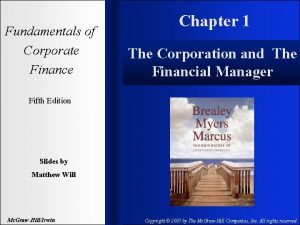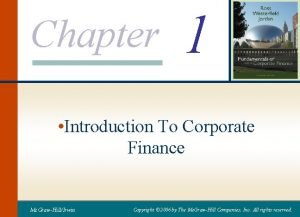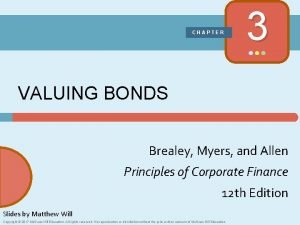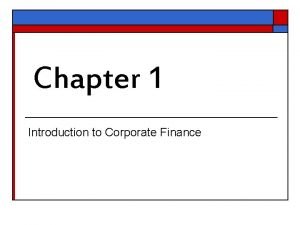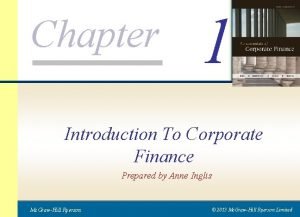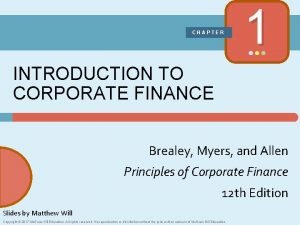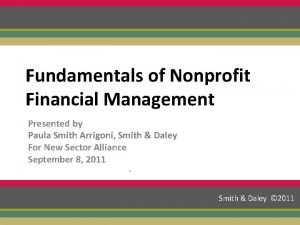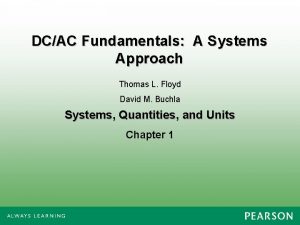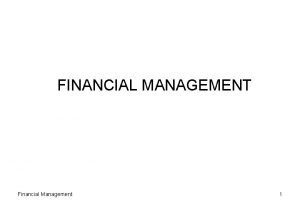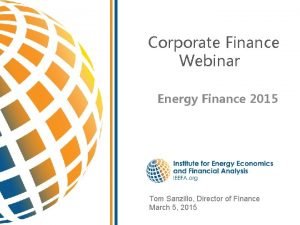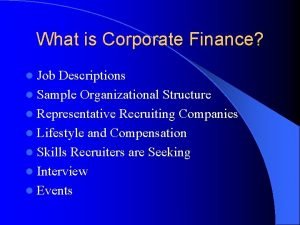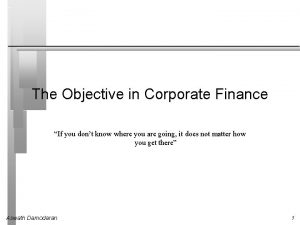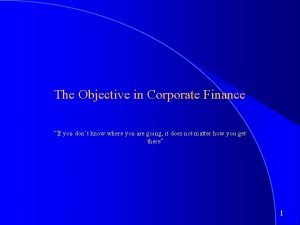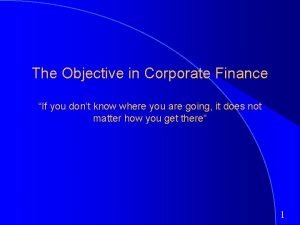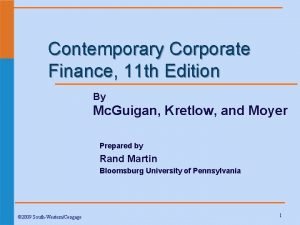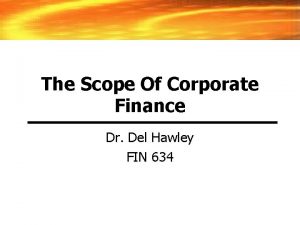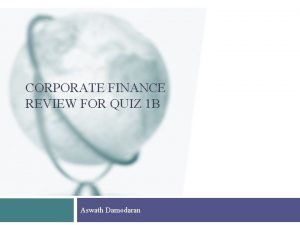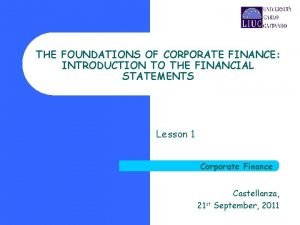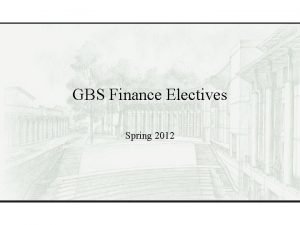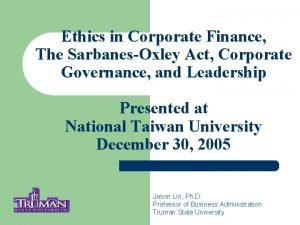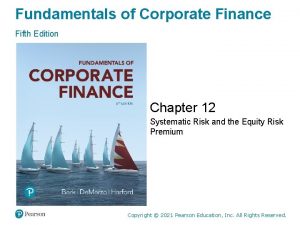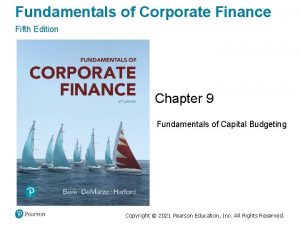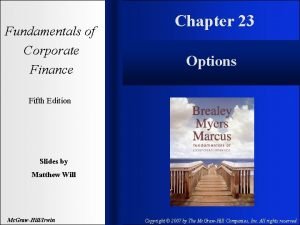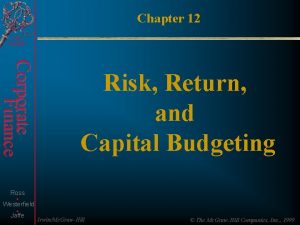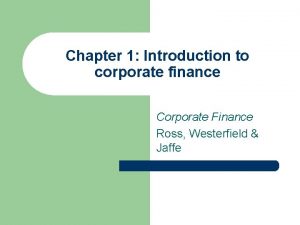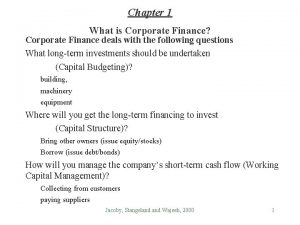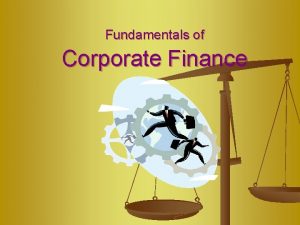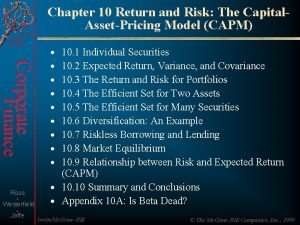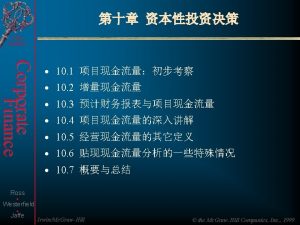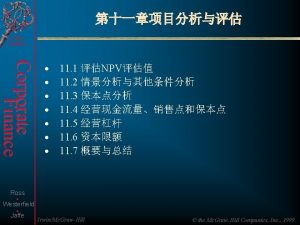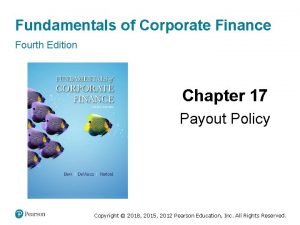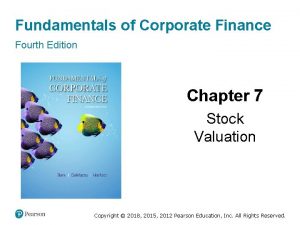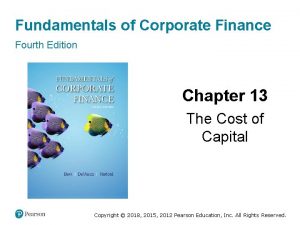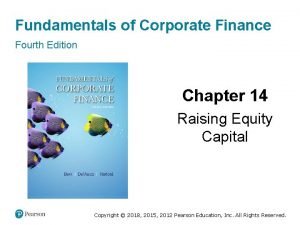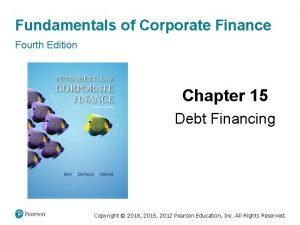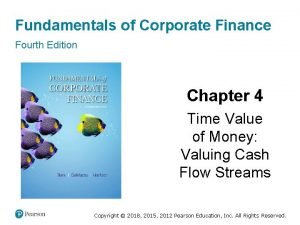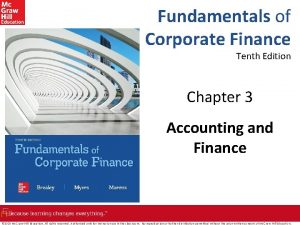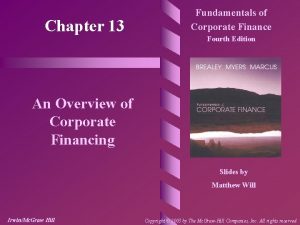Fundamentals of Corporate Finance Fifth Edition Chapter 21





























































- Slides: 61

Fundamentals of Corporate Finance Fifth Edition Chapter 21 Option Applications and Corporate Finance Slide in this Presentation Contain Hyperlinks. JAWS users should be able to get a list of links by using INSERT+F 7 Copyright © 2021 Pearson Education, Inc. All Rights Reserved.

Chapter Outline 21. 1 Option Basics 21. 2 Option Payoffs at Expiration 21. 3 Factors Affecting Option Prices 21. 4 The Black-Scholes Option Pricing Formula 21. 5 T Put-Call Parity 21. 6 Options and Corporate Finance Copyright © 2021 Pearson Education, Inc. All Rights Reserved.

Learning Objectives (1 of 2) • Understand basic option terminology • Explain the difference between calls and puts, how they pay off, and the profit from holding each to expiration • Analyze the factors that affect option prices • Be familiar with the Black-Scholes Option Pricing Formula Copyright © 2021 Pearson Education, Inc. All Rights Reserved.

Learning Objectives (2 of 2) • Describe the relationship that must hold between the prices of similar calls and puts on the same stock • Demonstrate how options are applied in corporate finance Copyright © 2021 Pearson Education, Inc. All Rights Reserved.

21. 1 Option Basics (1 of 5) • Financial Option – A contract that gives its owner the right (but not the obligation) to purchase or sell an asset at a fixed price at some future date § Call options § Put options Copyright © 2021 Pearson Education, Inc. All Rights Reserved.

21. 1 Option Basics (2 of 5) • Option Contracts – Terms: § Derivatives § Option Buyer/Option Holder – Long Position § Option Seller/Option Writer – Short Position § Warrants Copyright © 2021 Pearson Education, Inc. All Rights Reserved.

21. 1 Option Basics (3 of 5) • Option Contracts – Terms: § Exercising The Option § Strike Price/Exercise Price § Expiration Date § American Options § European Options Copyright © 2021 Pearson Education, Inc. All Rights Reserved.

Table 21. 1 The Language of Options Call option Option to buy the stock at a prespecified price Put option Option to sell the stock at a prespecified price Strike (exercise) price The prespecified price in the option contract Write an option Sell an option Exercise (an option) Enforce your right to buy or sell the stock as specified in the option contract Short/Long position The writer (seller) has a short position and the buyer has a long position in the option American option You can exercise the option any time on or before the expiration date European option You can exercise the option only on the expiration date Warrant A call option written by the firm whereby new stock will be issued if the warrant is exercised Copyright © 2021 Pearson Education, Inc. All Rights Reserved.

21. 1 Option Basics (4 of 5) • Stock Option Quotations – At-The-Money – In-The-Money § Deep In-The-Money – Out-Of-The-Money § Deep Out-Of-The-Money – Open Interest Copyright © 2021 Pearson Education, Inc. All Rights Reserved.

Table 21. 2 Option Quotes for Amazon. com Stock Source: Chicago Board Options Exchange at www. cboe. com. Copyright © 2021 Pearson Education, Inc. All Rights Reserved.

Example 21. 1 Purchasing Options (1 of 4) Problem: • It is May 16, 2019, and you have decided to purchase 10 June call contracts on Amazon’s stock with an exercise price of $1905. • Because you are buying, you must pay the ask price. • How much money will this purchase cost you? • Is this option in-the-money or out-of-the-money? Copyright © 2021 Pearson Education, Inc. All Rights Reserved.

Example 21. 1 Purchasing Options (2 of 4) Solution: Plan: • From Table 21. 2, the ask price of this option is $54. 75. • Remember that the price quoted is per share and that each contract is for 100 shares. Copyright © 2021 Pearson Education, Inc. All Rights Reserved.

Example 21. 1 Purchasing Options (3 of 4) Execute: • You are purchasing 10 contracts and each contract is on 100 shares, so the transaction will cost 54. 75 × 100 = $54, 750 (ignoring any commission fees). • Because this is a call option and the exercise price is above the current stock price ($1, 903. 73), the option is currently out-of-the-money. Copyright © 2021 Pearson Education, Inc. All Rights Reserved.

Example 21. 1 Purchasing Options (4 of 4) Execute: • Even though the option is currently out-of-the-money, it still has value. During the time left to expiration, the stock could rise above the exercise (strike) price of $1905. Copyright © 2021 Pearson Education, Inc. All Rights Reserved.

Example 21. 1 a Purchasing Options (1 of 4) Problem: • It is May 16, 2019, and you have decided to purchase 10 June call contracts on Amazon’s stock with an exercise price of $1895. • Because you are buying, you must pay the ask price. • How much money will this purchase cost you? • Is this option in-the-money or out-of-the-money? Copyright © 2021 Pearson Education, Inc. All Rights Reserved.

21. 1 Option Basics (5 of 5) • Options on Other Financial Securities – Hedging – Speculating Copyright © 2021 Pearson Education, Inc. All Rights Reserved.

21. 2 Option Payoffs at Expiration (1 of 4) • The Long Position in an Option Contract – When the stock price on the expiration date exceeds the strike price, the value of the call is the difference between the stock price and the strike price – When the stock price is less than the strike price at expiration, the holder will not exercise the call, so the option is worth nothing Copyright © 2021 Pearson Education, Inc. All Rights Reserved.

Figure 21. 1 Payoff of a Call Option with a Strike Price of $20 at Expiration Copyright © 2021 Pearson Education, Inc. All Rights Reserved.

21. 2 Option Payoffs at Expiration (2 of 4) • Call Value at Expiration Call Value = Stock Price − Strike Price, if Stock Price > Strike = 0, if Stock Price ≤ Strike (Eq. 21. 1) • Put Price at Expiration Put Value = Strike Price − Stock Price, if Stock Price < Strike = 0, if Stock Price ≥ Strike (Eq. 21. 2) Copyright © 2021 Pearson Education, Inc. All Rights Reserved.

Example 21. 2 Payoff of a Put Option at Maturity (1 of 4) Problem: • You own a put option on Oracle stock with an exercise price of $20 that expires today. • Plot the value of this option as a function of the stock price. Copyright © 2021 Pearson Education, Inc. All Rights Reserved.

Example 21. 2 Payoff of a Put Option at Maturity (2 of 4) Solution: Plan: • From Equation 21. 2, and the fact that the strike price is $20, we see that the value of the put option is Put Value = 20 − Stock Price, if Stock Price < 20 = 0, if Stock Price ≥ 20. Copyright © 2021 Pearson Education, Inc. All Rights Reserved.

Example 21. 2 Payoff of a Put Option at Maturity (3 of 4) Execute: • Plotting this function gives Copyright © 2021 Pearson Education, Inc. All Rights Reserved.

Example 21. 2 Payoff of a Put Option at Maturity (4 of 4) Evaluate: • Because the put option allows you to force the put writer to buy the stock for $20, regardless of the current market price, we can see that the put option payoff increases as Oracle’s stock price decreases. • For example, if Oracle’s price were $10, you could buy a share of Oracle in the market for $10 and then sell it to the put writer for $20, making a profit of $10. Copyright © 2021 Pearson Education, Inc. All Rights Reserved.

21. 2 Option Payoffs at Expiration (3 of 4) • The Short Position in an Option Contract – An investor holding a short position in an option has an obligation – The short position’s cash flows are the negative of the long position’s cash flows – Because an investor who is long an option can only receive money at expiration, a short investor can only pay money Copyright © 2021 Pearson Education, Inc. All Rights Reserved.

Figure 21. 2 Short Position in a Call Option at Expiration Copyright © 2021 Pearson Education, Inc. All Rights Reserved.

Example 21. 3 Payoff of a Short Position in a Put Option (1 of 4) Problem: • You are short a put option on Oracle stock with an exercise price of $20 that expires today. Plot the value of this option as a function of the stock price. Copyright © 2021 Pearson Education, Inc. All Rights Reserved.

Example 21. 3 Payoff of a Short Position in a Put Option (2 of 4) Solution: Plan: • Again, the strike price is $20 and in this case your cash flows will be opposite of those from Equation 21. 2, as depicted in the previous example. Thus, your cash flows will be Copyright © 2021 Pearson Education, Inc. All Rights Reserved.

Example 21. 3 Payoff of a Short Position in a Put Option (3 of 4) Execute: • The graph plots your cash flows: Copyright © 2021 Pearson Education, Inc. All Rights Reserved.

Example 21. 3 Payoff of a Short Position in a Put Option (4 of 4) Evaluate: • If the current stock price is $30, the put will not be exercised and you will owe nothing. If the current stock price is $15, the put will be exercised and you will lose $5. Comparing the graph here and in Example 21. 2, we see that the payoffs are mirror images of each other. Copyright © 2021 Pearson Education, Inc. All Rights Reserved.

21. 2 Option Payoffs at Expiration (4 of 4) • Profits for Holding an Option to Expiration – Although payouts on a long position in an option contract are never negative, the profit from purchasing an option and holding it to expiration could be negative § The payout at expiration might be less than the initial cost of the option Copyright © 2021 Pearson Education, Inc. All Rights Reserved.

Figure 21. 3 Profit from Holding a Call Option to Expiration Copyright © 2021 Pearson Education, Inc. All Rights Reserved.

Example 21. 4 Profit on Holding a Position in a Put Option Until Expiration (1 of 4) Problem • Assume you decided to purchase the June 1890 through 1905 put options quoted in Table 21. 2 on May 16, 2019, and you financed each position by borrowing at 3% for 37 days. Plot the profit of each position as a function of the stock price on expiration. Copyright © 2021 Pearson Education, Inc. All Rights Reserved.

Example 21. 4 Profit on Holding a Position in a Put Option Until Expiration (2 of 4) Solution: Plan: • Suppose P is the price of each put option on August 21. Then your cash flows on the expiration date will be: Copyright © 2021 Pearson Education, Inc. All Rights Reserved.

Example 21. 4 Profit on Holding a Position in a Put Option Until Expiration (3 of 4) Execute • The graph plots your profits: Copyright © 2021 Pearson Education, Inc. All Rights Reserved.

Example 21. 4 Profit on Holding a Position in a Put Option Until Expiration (4 of 4) Evaluate: • The graph illustrates the same tradeoff between the maximum loss and the potential for profit as for the call options in Figure 21. 3. • The greatest profit potential comes from the most expensive option, so if that option expires worthless, you have lost the greatest amount. Copyright © 2021 Pearson Education, Inc. All Rights Reserved.

Figure 21. 3 Option Returns from Purchasing an Option and Holding It to Expiration Copyright © 2021 Pearson Education, Inc. All Rights Reserved.

Table 21. 3 Payoffs, Profits and Returns to Buying or Writing Options in Table 21. 2 Copyright © 2021 Pearson Education, Inc. All Rights Reserved.

21. 3 Factors Affecting Option Prices (1 of 3) • Strike Price and Stock Price – For a given strike price, the value of a call option increases as the stock price increases – For a given strike price, the value of a put option decreases as the stock price increases Copyright © 2021 Pearson Education, Inc. All Rights Reserved.

21. 3 Factors Affecting Option Prices (2 of 3) • Option Prices and the Exercise Date – For American options, the longer the time to the exercise date, the more valuable the option – A European option with a later exercise date may potentially trade for less than an otherwise identical option with an earlier exercise date Copyright © 2021 Pearson Education, Inc. All Rights Reserved.

21. 3 Factors Affecting Option Prices (3 of 3) • Option Prices and the Risk-Free Rate – The value of a call option increases as the risk-free rate increase – The value of a put option decreases as the risk-free rate increase • Option Prices and Volatility – The value of an option increases as the volatility of the stock increases Copyright © 2021 Pearson Education, Inc. All Rights Reserved.

Table 21. 4 How an Increase in Each Factor Affects Option Values Copyright © 2021 Pearson Education, Inc. All Rights Reserved.

Example 21. 5 Option Value and Volatility (1 of 4) Problem: • Two European call options with a strike price of $50 are written on two different stocks. Suppose that tomorrow, the low-volatility stock will have a price of $50 for certain. • The high-volatility stock will be worth either $60 or $40, with each price having equal probability. • If the exercise date of both options is tomorrow, which option will be worth more today? Copyright © 2021 Pearson Education, Inc. All Rights Reserved.

Example 21. 5 Option Value and Volatility (2 of 4) Solution: Plan: • The value of the options will depend on the value of the stocks at expiration. • The value of the options at expiration will be the stock price tomorrow minus $50 if the stock price is greater than $50, and $0 otherwise. Copyright © 2021 Pearson Education, Inc. All Rights Reserved.

Example 21. 5 Option Value and Volatility (3 of 4) Execute: • The low-volatility stock will be worth $50 for certain, so its option will be worth $0 for certain. The highvolatility stock will be worth either $40 or $60, so its option will pay off either $0 or $60 − $50 = $10. • Because options have no chance of a negative payoff, the one that has a 50% chance of a positive payoff has to be worth more than the option on the low-volatility stock (with no chance of a positive payoff). Copyright © 2021 Pearson Education, Inc. All Rights Reserved.

Example 21. 5 Option Value and Volatility (4 of 4) Evaluate: • Because volatility increases the chance that an option will pay off, the options have very different values even though the expected value of both stocks tomorrow is $50—the low-volatility stock will be worth this amount for sure, and the high-volatility stock also has an expected value of Copyright © 2021 Pearson Education, Inc. All Rights Reserved.

21. 4 The Black-Scholes Option Pricing Formula • Black-Scholes Price of a Call Option on a Non-Dividend. Paying Stock (Eq. 21. 3) where: Copyright © 2021 Pearson Education, Inc. All Rights Reserved.

Figure 21. 5 Online Option Pricing Calculator Source: http: //www. optionseducation. org. Copyright © 2021 Pearson Education, Inc. All Rights Reserved.

21. 5 Put-Call Parity (1 of 3) • Portfolio Insurance – Protective Put § Purchasing a put option on a stock you already own – Portfolio Insurance § A protective put written on a portfolio rather than a single stock Copyright © 2021 Pearson Education, Inc. All Rights Reserved.

Figure 21. 6 Portfolio Insurance Copyright © 2021 Pearson Education, Inc. All Rights Reserved.

21. 5 Put-Call Parity (2 of 3) • Portfolio Insurance – Put-Call Parity: Non-Dividend-Paying Stock § Consider the two different ways to construct portfolio insurance illustrated in the example: – Purchase the stock and a put – Purchase a bond a call • Because both positions provide exactly the same payoff, the Law of One Price, requires that they must have the same price: Stock Price + Put Price = PV(Strike Price) + Call Price Copyright © 2021 Pearson Education, Inc. All Rights Reserved.

21. 5 Put-Call Parity (3 of 3) • Portfolio Insurance – Put-Call Parity: Non-Dividend-Paying Stock § Put-Call Parity – Stock Price + Put Price = PV(Strike Price) + Call Price • Rearranging terms gives an expression for the price of a European call option for a nondividend-paying stock: – Call Price = Put Price + Stock Price − PV(Strike Price) Copyright © 2021 Pearson Education, Inc. All Rights Reserved.

Example 21. 6 Using Put-Call Parity (1 of 5) Problem: • You are an options dealer who deals in non-publicly traded options. One of your clients wants to purchase a one-year European call option on HAL Computer Systems stock with a strike price of $20. • Another dealer is willing to write a one-year European put option on HAL stock with a strike price of $20, and sell you the put option for a price of $2. 50 per share. • If HAL pays no dividends and is currently trading for $18 per share, and if the risk-free interest rate is 6%, what is the lowest price you can charge for the call option and still guarantee yourself a profit? Copyright © 2021 Pearson Education, Inc. All Rights Reserved.

Example 21. 6 Using Put-Call Parity (2 of 5) Solution: Plan: • We can use put-call parity to determine the price of the option: Call Price = Put Price + Stock Price − PV(Strike Price) • In order to price a one-year European call with a strike price of $20, we need to know the price of a one-year European put with the same strike price, the current stock price, and the risk-free interest rate. • We have all of that information, so we’re ready. Copyright © 2021 Pearson Education, Inc. All Rights Reserved.

Example 21. 6 Using Put-Call Parity (3 of 5) Execute: Copyright © 2021 Pearson Education, Inc. All Rights Reserved.

Example 21. 6 Using Put-Call Parity (4 of 5) Evaluate: • Put-call parity means that we can replicate the payoff of the one-year call option with a strike price of $20 by holding the following portfolio: Buy the one-year put option with a strike price of $20 from the dealer, buy the stock, and sell a one-year, risk-free zero-coupon bond with a face value of $20. • With this combination, we have the following final payoff, depending on the final price of HAL stock in one year, S 1: Copyright © 2021 Pearson Education, Inc. All Rights Reserved.

Example 21. 6 Using Put-Call Parity (5 of 5) Evaluate: • Note that the final payoff of the portfolio of the three securities matches the payoff of a call option. • Therefore, we can sell the call option to our client and have future payoff of zero no matter what happens. • Doing so is worthwhile as long as we can sell the call option for more than the cost of the portfolio, which we found to be $1. 632. Copyright © 2021 Pearson Education, Inc. All Rights Reserved.

21. 6 Options and Corporate Finance • Option to delay, change, or abandon a project • Option to call a bond early • Stock can be thought of as a call option on the assets of the firm with a strike price equal to the value of debt outstanding Copyright © 2021 Pearson Education, Inc. All Rights Reserved.

Figure 21. 7 Equity as a Call Option Copyright © 2021 Pearson Education, Inc. All Rights Reserved.

Chapter Quiz (1 of 2) 1. What is the difference between a European option and an American option? 2. How are the payoffs to buying a call option related to the payoffs from writing a call option? 3. Why are options more valuable when there is increased uncertainty about the value of the stock? Copyright © 2021 Pearson Education, Inc. All Rights Reserved.

Chapter Quiz (2 of 2) 4. Explain put-call parity. 5. Explain how equity can be viewed as a call option on the firm. Copyright © 2021 Pearson Education, Inc. All Rights Reserved.

Copyright This work is protected by United States copyright laws and is provided solely for the use of instructors in teaching their courses and assessing student learning. Dissemination or sale of any part of this work (including on the World Wide Web) will destroy the integrity of the work and is not permitted. The work and materials from it should never be made available to students except by instructors using the accompanying text in their classes. All recipients of this work are expected to abide by these restrictions and to honor the intended pedagogical purposes and the needs of other instructors who rely on these materials. Copyright © 2021 Pearson Education, Inc. All Rights Reserved.
 Fundamentals of corporate finance fifth edition
Fundamentals of corporate finance fifth edition Fundamentals of corporate finance 3rd canadian edition
Fundamentals of corporate finance 3rd canadian edition Fundamentals of corporate finance third canadian edition
Fundamentals of corporate finance third canadian edition Corporate finance 6th edition
Corporate finance 6th edition Fundamentals of corporate finance chapter 6 solutions
Fundamentals of corporate finance chapter 6 solutions Fundamentals of corporate finance (doc or html) file
Fundamentals of corporate finance (doc or html) file Fundamentals of corporate finance, chapter 1
Fundamentals of corporate finance, chapter 1 Objectives of corporate finance
Objectives of corporate finance Corporate finance tenth edition
Corporate finance tenth edition Corporate finance tenth edition
Corporate finance tenth edition Corporate finance tenth edition
Corporate finance tenth edition Corporate finance tenth edition
Corporate finance tenth edition Corporate finance tenth edition
Corporate finance tenth edition Principles of marketing fifth european edition
Principles of marketing fifth european edition Lazarus theory
Lazarus theory Fifth edition chemistry a molecular approach
Fifth edition chemistry a molecular approach Segregat
Segregat Molecular biology
Molecular biology Human anatomy fifth edition
Human anatomy fifth edition Human anatomy fifth edition
Human anatomy fifth edition Introduction to corporate finance what companies do
Introduction to corporate finance what companies do Principles of corporate finance chapter 3 solutions
Principles of corporate finance chapter 3 solutions Corporate finance chapter 1
Corporate finance chapter 1 Chapter 1 introduction to corporate finance
Chapter 1 introduction to corporate finance Chapter 1 introduction to corporate finance
Chapter 1 introduction to corporate finance Finance fundamentals for nonprofits
Finance fundamentals for nonprofits Real estate finance fundamentals
Real estate finance fundamentals Fundamentals of information systems 9th edition
Fundamentals of information systems 9th edition Fundamentals of information systems 9th edition
Fundamentals of information systems 9th edition Fluid mechanics fundamentals and applications 3rd edition
Fluid mechanics fundamentals and applications 3rd edition Thomas l floyd digital fundamentals 10th edition
Thomas l floyd digital fundamentals 10th edition Machining fundamentals 10th edition
Machining fundamentals 10th edition Fundamentals of organizational communication 9th edition
Fundamentals of organizational communication 9th edition Fundamentals of organizational communication 9th edition
Fundamentals of organizational communication 9th edition Digital fundamentals by floyd 10th edition
Digital fundamentals by floyd 10th edition Digital fundamentals floyd ppt
Digital fundamentals floyd ppt Dc/ac fundamentals a systems approach
Dc/ac fundamentals a systems approach Computer security fundamentals 4th edition
Computer security fundamentals 4th edition Management fundamentals 8th edition
Management fundamentals 8th edition Fundamentals of information systems
Fundamentals of information systems Lysanx
Lysanx Fundamentals of information systems 9th edition
Fundamentals of information systems 9th edition Fundamentals of heat and mass transfer 4th edition
Fundamentals of heat and mass transfer 4th edition The fundamentals of political science research 2nd edition
The fundamentals of political science research 2nd edition Modern finance theory
Modern finance theory Corporate finance webinar
Corporate finance webinar Corporate finance vs investment banking
Corporate finance vs investment banking Corporate finance job scope
Corporate finance job scope Objective of corporate finance
Objective of corporate finance Objectives of corporate finance
Objectives of corporate finance Objective of corporate finance
Objective of corporate finance Maastricht university ib
Maastricht university ib Contemporary corporate finance
Contemporary corporate finance Scope of corporate finance
Scope of corporate finance Objectives of corporate finance
Objectives of corporate finance Corporate finance quiz
Corporate finance quiz Corporate finance law firm hong kong
Corporate finance law firm hong kong Corporate finance syllabus
Corporate finance syllabus Foundations of corporate finance
Foundations of corporate finance Gbs corporate finance
Gbs corporate finance Ethics in corporate finance
Ethics in corporate finance Corporate finance overview
Corporate finance overview






